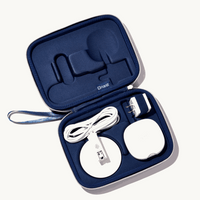Whether you just saw those two magical pink lines or you’re already rocking a baby bump, one of most urgent questions buzzing in your head is probably: “When is this baby coming?” Understanding your due date is more than just circling a day on the calendar—it’s your pregnancy north star, guiding you through all the excitement, prep, and “oh wow, this is actually happening” moments ahead.
Due date calculators have become essential tools for expectant parents, helping you estimate when your little one will arrive and plan accordingly. While these calculators provide valuable guidance, it's important to understand how they work, their limitations, and how to use them effectively to help guide you during your pregnancy. For more info, you can also check out our guide to questions to ask your OBGYN at your first prenatal visit.
How do Due Date Calculators Work?
Due date calculators are digital tools that estimate when your baby will be born based on information about your pregnancy. These calculators use established medical formulas and algorithms to provide you with an estimated delivery date (EDD), which serves as a target date for your baby's arrival.
The most common calculation method is based on Naegele's Rule, which assumes a 280-day (40-week) pregnancy calculated from the first day of your last menstrual period (LMP). This assumes that you have a regular 28-day menstrual cycle and that ovulation occurred on day 14 of your cycle. The formula is straightforward: add 280 days to your LMP date.
But now, modern due date calculators incorporate additional factors such as cycle length variations, conception date estimates, and ultrasound results to provide more personalized and accurate predictions. These advanced calculators recognize that everyone's cycle is unique and that pregnancy varies significantly from person to person.
Different Ways to Calculate Your Due Date
Last Menstrual Period (LMP) Method
The LMP method is the most popular approach for calculating due dates. This method requires you to know the exact date of the first day of your last normal menstrual period, not any spotting or irregular bleeding that might have occurred after conception.
Best for: If you have regular, predictable cycles and can accurately recall your LMP date.
Conception Date Method
If you tracked your ovulation or used fertility treatments, you might already know (or have a good guess) when you conceived. Starting the count from the conception date can sometimes be more precise.
Best for: If you were actively trying to conceive and tracking ovulation or using fertility treatments.
Ultrasound-Based Calculations
An ultrasound, especially during the first trimester, can provide highly accurate due date estimates based on fetal measurements that correspond to specific gestational ages. Early ultrasounds (before 20 weeks) are generally considered more accurate than LMP-based calculations.
Best for: If you have an irregular cycle or don't know your LMP date.
|
Calculation Method |
Accuracy |
Best Used When |
Limitations |
|
LMP Method |
±2 weeks |
Regular cycles, known LMP |
Assumes 28-day cycle |
|
Conception Date |
±1-2 weeks |
Known ovulation/conception |
Requires accurate conception timing |
|
Ultrasound-Based |
±1 week |
Early pregnancy scans |
Depends on measurement accuracy |
How Accurate are Due Date Calculators?
Real talk: Only about 5% of babies are actually born on their calculated due date. This doesn't mean the calculators are wrong—it means that pregnancy has natural variations that can't be perfectly predicted.
Most healthy babies are born two weeks before or after their due date. This four-week window (from 38 to 42 weeks of pregnancy) is considered "full-term," and delivery anywhere within this range is typically normal and healthy.
Factors That Can Affect Your Due Date
-
Cycle Length: If your cycle is typically longer or shorter cycles than the textbook 28 days, ovulation and due date can shift
-
First Baby vs Siblings: First babies often hang out a little longer!
-
Genetics: Family history of early or late deliveries can play a part
-
Multiple Pregnancies: Twins and triplets usually arrive early
-
Medical Conditions: Certain health conditions can also affect pregnancy length
Managing Expectations About Your Due Date
Think of your due date as an estimate rather than an exact deadline. Focus on preparing for your baby's arrival during the full-term window (37-42 weeks) rather than fixating on one specific date. This mindset can help reduce anxiety and disappointment if your baby doesn't arrive "on time."
How to Effectively Use a Due Date Calculator
1. Get Your Facts Straight
Make sure you have accurate information about your menstrual cycle: This includes the exact date of your last menstrual period, your typical cycle length, and any irregularities you've noticed. The more accurate your info, the more reliable your calculated due date will be.
2. Try a Few Calculators
Different calculators may use slightly different algorithms or take different factors into account. Try using several reputable calculators to get a range of estimates. If they all provide similar dates, you can be more confident in the accuracy.
3. Consider Your Individuality
Remember that calculators provide estimates based on averages. Consider your own factors, such as cycle length, age, and pregnancy history, when interpreting results. You should also go to your healthcare provider for personalized guidance.
4. Be Flexible
As you receive ultrasound measurements and other clinical information throughout your pregnancy, be open to adjusting your due date estimate. Your healthcare provider may recommend changes based on more precise measurements or clinical observations.
Planning Ahead
Once you have your estimated due date, you can begin planning for your baby's arrival. This includes both practical and emotional preparations for the big day. Understanding your timeline helps you prepare gradually and ensures you're ready when your little one decides to make their appearance.
Peace of Mind, Delivered in HD
The Nanit Pro Smart Baby Monitor is a game-changer for new parents— it helps you create a safe, monitored sleep environment from day one. Track sleep, breathing, and milestones without hovering. Trust us, those early weeks are easier when you have that extra insight into how your little one is doing.
Creating Your Baby's Environment
One of the most exciting aspects of knowing your due date is being able to prepare your home to welcome your baby. Most experts recommend having your nursery ready by 36 weeks, giving you time to nest while maintaining energy during your second trimester.
Consider exploring resources for new parents, like our essential nursery items for newborns, which covers everything from safety essentials to monitoring tools that will help you feel confident as a new parent.
Parent Smarter, Not Harder
When your baby sleeps well, you sleep well—and we're here to help. The Nanit Sound + Light Machine helps establish healthy sleep habits from birth. With customizable sounds and gentle lighting, it creates a calming environment that supports your baby's sleep development right from your phone.
Packing Your Hospital Bag
Your due date also helps you plan when to pack your hospital bag and prepare for labor and delivery. Healthcare providers usually recommend having your bag ready by 36 weeks, well before your due date, so you're not caught off guard if your baby arrives early.
Our comprehensive hospital bag checklist covers everything you need to pack for both you and your partner, ensuring you're fully prepared for your hospital stay.
Building Your Support Systems
Knowing your due date allows you to coordinate with family members, friends, and other people in your circle who will help you during labor, delivery, and the postpartum period. This might include arranging for childcare for older children, meal preparation, or simply having emotional support available.
The Takeaway
Due date calculators are great for planning and shaping the timeline of your pregnancy, but remember: your baby will come when they're ready, not when the calendar says.
Focus on the things you can control: maintaining good prenatal care, preparing your home and family for your baby's arrival, and building the support systems you'll need. Celebrate the milestones these calculators help you track, but stay flexible and try your best not to get too attached to any specific dates.
Most importantly, remember that your due date is just the beginning of your journey as a parent. The love, care, and attention you're showing now in planning and preparing will continue to be the foundation of your relationship with your child for years to come.











































